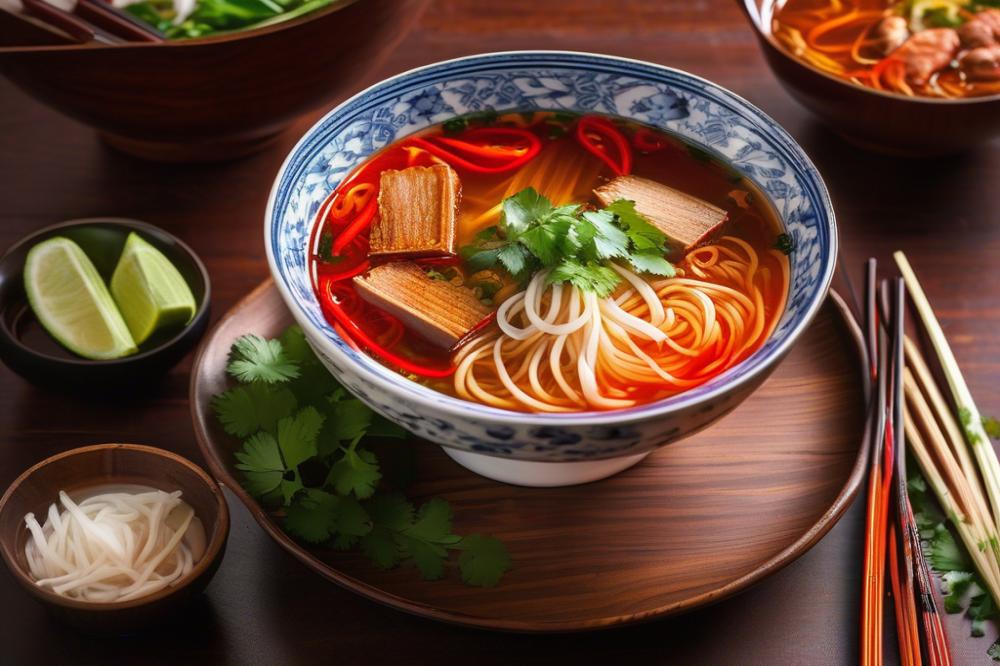Exploring Bún Bò Huế: A Vietnamese Delight
Bún Bò Huế is a classic spicy noodle soup that captures the essence of Vietnamese cuisine. Originating from the ancient city of Huế, this dish holds a special place in the hearts of many. Locals often celebrate its rich traditions, making it much more than just a meal.
Distinctive for its deep, spicy broth, Bún Bò Huế brims with flavors that tantalize the taste buds. This soup typically features tender beef, which is sliced to perfection. One of the key ingredients that enhances its aroma is lemongrass. This herb adds a fresh and vibrant note to the dish, making it even more enjoyable.
Throughout Vietnam, the popularity of this dish is undeniable. Many families have their own cherished recipe, contributing to a rich tapestry of variations. It often includes a mix of fresh herbs, along with rice noodles that are soft and chewy. Each bowl showcases a unique combination of flavors and textures that can quickly satisfy any appetite.
Cultural significance is another important aspect of Bún Bò Huế. It represents the culinary heritage of Vietnam and tells a story of its people. Pho may often steal the spotlight, but this spicy noodle soup is a worthy contender celebrated for its boldness. With each delicious spoonful, you experience the warmth of Vietnamese hospitality and tradition.
Indulges in the heart of this dish, and you will discover not just a meal, but a rich culture steeped in history.
The Essence of Bún Bò Huế
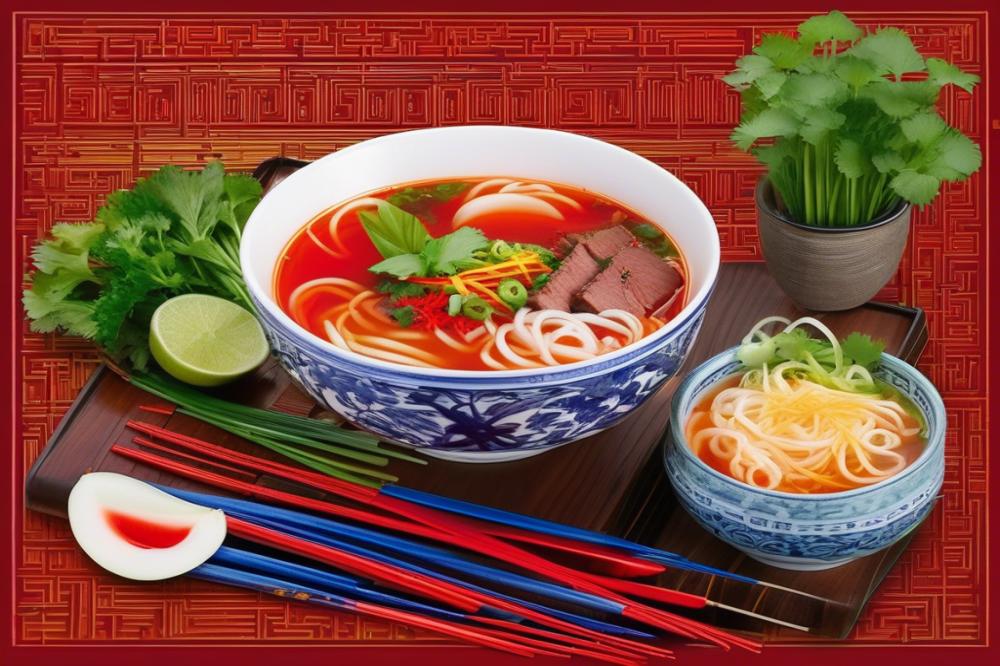

Bún Bò Huế is a vibrant dish bursting with flavor. Its broth is rich, aromatic, and distinctly spicy, making it different from other soups in Vietnamese cuisine. The use of lemongrass is crucial in creating its refreshing taste. This fragrant herb adds a citrusy note that balances the savory aspects of the broth.
Spices play a significant role as well. A blend of chili, shrimp paste, and sometimes even cinnamon contributes to the soup’s complexity. Each ingredient is thoughtfully selected to create a harmonious flavor profile that is both bold and inviting. Fresh herbs are typically added just before serving, enhancing the aroma and adding a bright freshness to the dish.
When comparing Bún Bò Huế with pho, differences become clear. Pho often features a lighter broth, with a focus on beef or chicken and fragrant star anise. In contrast, Bún Bò Huế has a heartier, spicier broth, often enriched with beef shank and pork. The rice noodles vary too; Bún Bò Huế uses thicker, round noodles, lending a chewy texture that complements the soup.
This dish is more than just a meal; it’s a celebration of flavors. With each spoonful, you can experience the warmth of spices mingled with the zest of lemongrass. It’s a comforting option, especially on rainy days, and it’s a staple for those craving something spicy and satisfying. Preparing this recipe allows one to explore the depths of Vietnamese cooking. The balance of ingredients brings families together at the dinner table.
Ingredients and Cooking Instructions
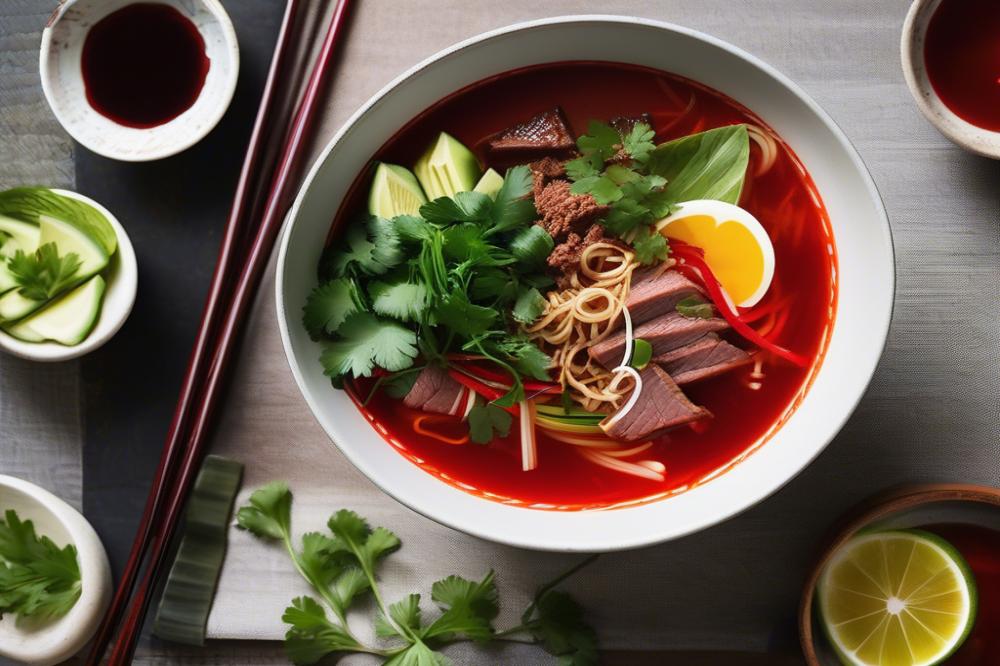

Ingredients List
- Beef shank: 500g
- Pork knuckle: 300g
- Rice noodles (bún): 400g
- Lemongrass: 3 stalks
- Onion: 1 large
- Chili paste: 2 tablespoons
- Shrimp paste: 1 teaspoon
- Fish sauce: 3 tablespoons
- Ginger: 1 piece
- Mint leaves, cilantro, and lime for garnish
Cooking Instructions
Start by preparing the broth. Boil the beef shank and pork knuckle in a large pot. Add lemongrass, onion, ginger, and any spices you enjoy for flavor. The broth needs to simmer for several hours. This low and slow process develops rich flavors that make this dish truly special.
Cooking the rice noodles is simple. Follow the package instructions to get the noodles just right. Once done, drain and rinse them with cold water to stop the cooking process.
Now, it’s time to assemble the dish. Place the cooked rice noodles in bowls. Ladle the hot broth over the noodles generously. Add tender slices of beef on top; they will continue to cook slightly in the hot broth.
For finishing touches, garnish with fresh herbs, such as mint and cilantro. A squeeze of lime adds a refreshing twist. Drizzle chili paste according to your spice tolerance for an added kick.
Nutritional Information
Each serving of this Vietnamese noodle soup offers a hearty balance of protein from beef and pork. Lemongrass brings benefits like antibacterial properties and aids digestion. The shrimp paste adds depth and enhances flavor while offering key nutrients. Fresh herbs provide vitamins and antioxidants.
This dish is not just tasty; it also supports wellness. The variety of ingredients contributes to a nutritious meal. Every bowl serves comfort and satisfaction, making it a favorite in many households.
Serving Suggestions and Variations
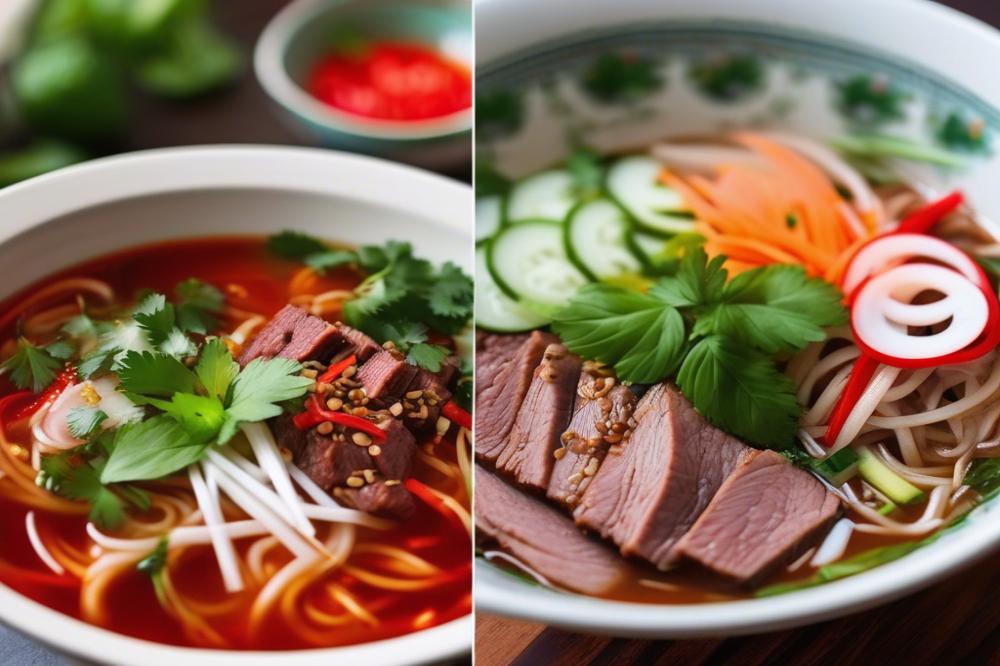

Bún Bò Huế is often served in deep bowls with vibrant colors and tempting aromas. Plating this dish goes beyond just filling a bowl. Presentation can elevate the dining experience. Fresh herbs, including mint, Thai basil, and cilantro, bring life to the meal. Lime wedges sit on the side, inviting a splash of tangy brightness. A drizzle of chili oil can add extra heat for spice lovers.
Sides play an important role as well. Pairing the noodle soup with crispy fried shallots creates a delightful crunch. Another popular accompaniment is fresh bean sprouts, lending texture and freshness. Some people enjoy a cold side of pickled vegetables. These offer a contrast to the hot soup.
There’s room for creativity in variations of this recipe. For those seeking a meatless option, tofu can be a satisfying substitute for beef. Plant-based proteins absorb the spicy broth beautifully. Additionally, many prefer chicken or pork instead of beef. Each choice changes the profile of the soup while keeping it delicious.
Homemade broth is where the flavor truly develops. Ingredients like lemongrass and shrimp paste add depth. This delicious base can be crafted using different spices to suit your palate. Don’t overlook the potential of adding more heat or different spices, such as ginger or chili powder.
Herbs take center stage in customizing bowls. Different combinations can dramatically change your experience. Adding more greens enhances freshness, while items like chili peppers elevate the spice level significantly. Including unique ingredients can surprise the taste buds.
A bowl of spicy Vietnamese cuisine should be as unique as the person enjoying it. Its adaptability makes it approachable for everyone. Each meal can transform, becoming a personal reflection of taste and preference. Curate your bowl to match your mood and invite others to do the same.
Cultural Significance
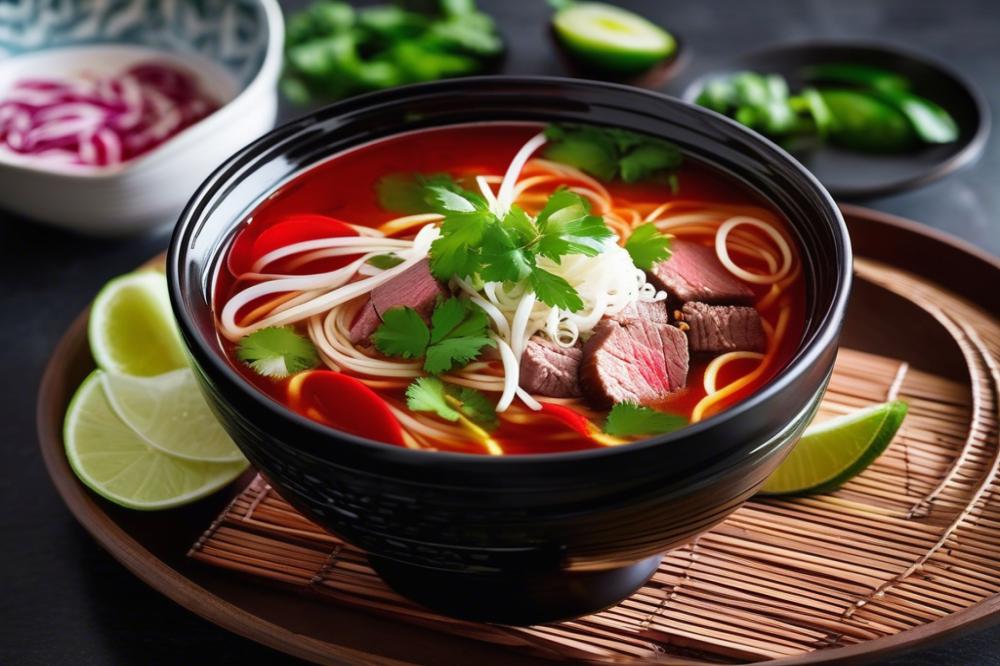

Bún Bò Huế holds a special place in Vietnamese cuisine. Many families enjoy this spicy noodle soup during festivals and special occasions. The bowl of noodle soup often brings people together, creating a sense of unity. At family gatherings, it is common for everyone to share a large pot, laughing and enjoying one another’s company.
Comfort food means different things to different people. For many in Vietnam, a warm bowl of Bún Bò Huế can chase away the chill of winter or lift spirits during tough times. The taste of beef, combined with the refreshing notes of lemongrass and aromatic herbs, offers not just nourishment but also a feeling of home.
Regional styles influence how this dish is prepared and served across the country. In Huế, locals often prefer a spicier broth, packed with fresh ingredients and a rich mixture of flavors. Comparatively, in the North, you might find variations that incorporate more herbs, reflecting a different taste profile. Meanwhile, the South often adapts the recipe to include sweeter elements, showcasing the diversity within Vietnamese cuisine.
Connection to heritage is vital too. Many recipes are passed down through generations. Elders teach younger family members the secret to the perfect broth, enriched with spices and time. This practice fosters a sense of identity and pride in their cultural background. When eating Bún Bò Huế, people cherish the tradition and flavors passed on through family.
Whether enjoyed at street stalls or fine dining establishments, this dish continues to evoke memories. Each bowl tells a story of place and time, connecting those who enjoy it. Many love to take their time savoring the delicate rice noodles, fragrant broth, and tender beef. The delightful mix of textures and tastes makes it an unforgettable experience.
Final Thoughts
Bún Bò Huế stands out as a beloved Vietnamese dish filled with rich flavors and history. This spicy noodle soup not only warms the body but also delights the senses. Each taste tells a story of cultural heritage, bringing together influences from various regions of Vietnam. The combination of tender beef, fragrant herbs, and delicate noodles creates an unforgettable experience in every bowl.
As you dive into making this recipe, you’re joining a tradition that has been cherished for generations. Cooking it allows you to connect with the heart of Vietnamese cuisine. Sharing this dish with family and friends enhances the joy it brings. Do not miss out on the opportunity to savor the vibrant tastes that define this classic meal.
Exploring Bún Bò Huế is more than just about eating; it’s about embracing a piece of Vietnam’s culinary landscape. So, gather your ingredients and embark on this delightful cooking adventure. You’ll be rewarded with a comforting bowl full of bold flavors and a sense of accomplishment. Experience the heart and soul behind this dish, and discover why it holds such a significant place in Vietnamese culture.

